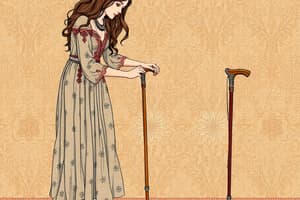Podcast
Questions and Answers
What type of walker provides the widest base of support and is very stable?
What type of walker provides the widest base of support and is very stable?
- Standard Walker (correct)
- Rolling Walker
- Reciprocal Walker
- Hemiwalker
For what specific patient condition is a rolling walker primarily indicated?
For what specific patient condition is a rolling walker primarily indicated?
- Post-surgical patients with upper extremity weakness (correct)
- Patients with full weight-bearing capability
- Patients who require minimal support while ambulating
- Patients who can independently manage stairs
What is the correct elbow flexion angle when measuring assistive devices?
What is the correct elbow flexion angle when measuring assistive devices?
- 45-50°
- 30-35°
- 20-25° (correct)
- 10-15°
Which of the following devices should never be used on stairs?
Which of the following devices should never be used on stairs?
What is a key requirement for a patient using crutches?
What is a key requirement for a patient using crutches?
Which crutch type is commonly used for patients who need to progress to unilateral support?
Which crutch type is commonly used for patients who need to progress to unilateral support?
What is the main purpose of using a hemiwalker?
What is the main purpose of using a hemiwalker?
What is a common characteristic of a reciprocal walker?
What is a common characteristic of a reciprocal walker?
Which type of assistive device is NOT designed for gait training?
Which type of assistive device is NOT designed for gait training?
What is the main reason for choosing different assistive devices for patients?
What is the main reason for choosing different assistive devices for patients?
Flashcards
Assistive Devices (AD)
Assistive Devices (AD)
Devices supporting ambulation for patients with orthopedic gait issues.
Parallel Bars
Parallel Bars
Provide maximum stability for walking.
Walker (Standard)
Walker (Standard)
Bilateral device for weight-bearing issues; suitable for stairs.
Walker (Rolling)
Walker (Rolling)
Signup and view all the flashcards
Walker (Reciprocal)
Walker (Reciprocal)
Signup and view all the flashcards
Crutches
Crutches
Signup and view all the flashcards
Axillary Crutches
Axillary Crutches
Signup and view all the flashcards
Forearm Crutches
Forearm Crutches
Signup and view all the flashcards
Hemiwalker
Hemiwalker
Signup and view all the flashcards
Quad Cane
Quad Cane
Signup and view all the flashcards
Study Notes
Assistive Devices (AD)
-
Assistive devices provide support and aid in ambulation for patients with orthopedic conditions impacting gait training.
-
Devices are categorized based on the level of support they provide, from the most supportive to the least supportive, with selection depending on individual patient needs.
Parallel Bars
- Provide the widest base of support for maximum stability.
Walker
- A bilateral device for patients with weight-bearing restrictions (NWB, WBAT, TDWB, PWB) or balance difficulties.
- Standard Walker (SW): Suitable for use on stairs with assistance.
- Rolling Walker (RW): Has wheels for easier movement, particularly for patients with balance issues and upper extremity weakness, but should not be used on stairs.
- Reciprocal Walker: Allows movement of one side at a time and is used for patients with slow and difficult ambulation, such as those with multiple trauma injuries.
- Measurement: Elbows flexed at 20-25 degrees, alternative methods include aligning the walker with the greater trochanter, wrist crease, or ulnar styloid.
Crutches
- Bilateral devices for patients with weight-bearing restrictions (NWB, WBAT, TDWB, PWB).
- Requires good balance for safe use.
- Can be used bilaterally or progress to unilateral use for patients improving weight-bearing status (e.g., ACL repair).
- Expand the base of support (BOS) for increased stability.
- Offer a wider range of gait patterns and allow for near-normal ambulation speed.
Axillary Crutches
- Made of wood or aluminum, available in regular or offset designs.
Forearm Crutches (Lofstrand, Canadian)
- Provide stability and support with forearm cuff and a handgrip.
Hemiwalker
- A single crutch with a wide base for support, used for patients with unilateral weight-bearing restrictions or weakness.
Quad Cane
- A lightweight, single-point cane for patients needing minimal support.
- Provides stability with its four-pronged base.
- Ideal for patients with mild balance issues or minor weight-bearing restrictions.
Studying That Suits You
Use AI to generate personalized quizzes and flashcards to suit your learning preferences.




